Dell UltraSharp U2711: Quality has a Price
by Jarred Walton on January 22, 2010 2:00 AM EST- Posted in
- Displays
Dell U2711 Color Quality
We'll start with a look at the color quality of the U2711, broken down into two areas: Color gamut and color accuracy (i.e. Delta E). We'll start by explaining the former. Color gamut refers to the ability for a display to represent all of the colors in a defined selection of colors. In this case, we use the Adobe RGB standard to define the base gamut, and we measure the percentage of that standard that a display is able to cover - higher being better.
Delta E is the difference between a requested color and the color that actually appears on the display, with lower being better - i.e. the displayed color doesn't have a large delta relative to what was requested. If a display has perfect color accuracy, Delta E will be 0.0; in practice, anything less than 1.0 is nearly perfect and no one will notice the difference. A Delta E of 2.0 or less is the desired result after calibration, meaning no one color measures higher than 2.0 on our standard 24 color palette. Such a result would be fit for use in any professional imaging environment. Finally, while Delta E of around 4.0 is visible to the naked eye, it's really a question of reference points; if you don't have something better nearby and you're not going to print or view content on other media, a result where all colors measure 4.0 or less is very good.
So how does the U2711 do in these areas? First let's look at the charts, and then we'll discuss what they mean. We used the Graphics and Adobe RGB setting on the U2711, with brightness set at 36% (~200nits) and contrast at the default 50%.
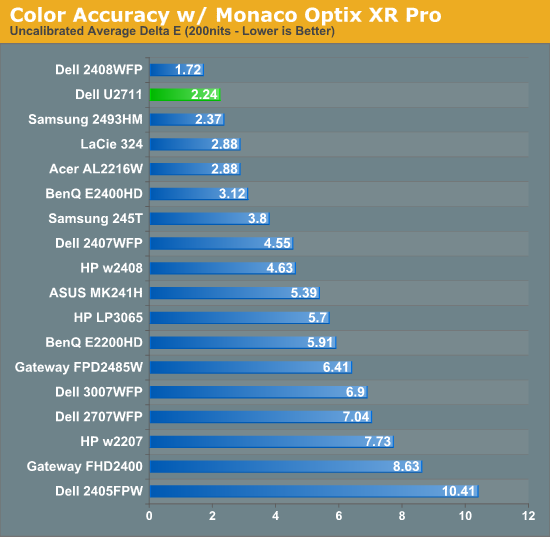
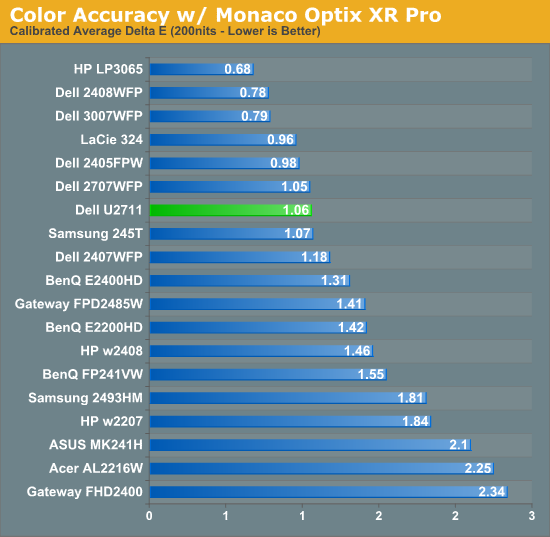
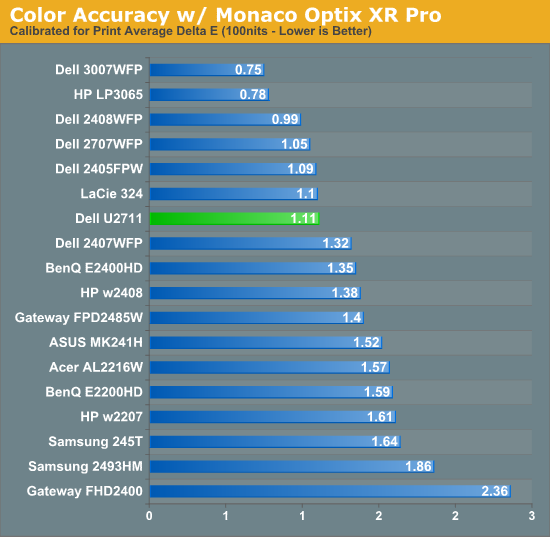
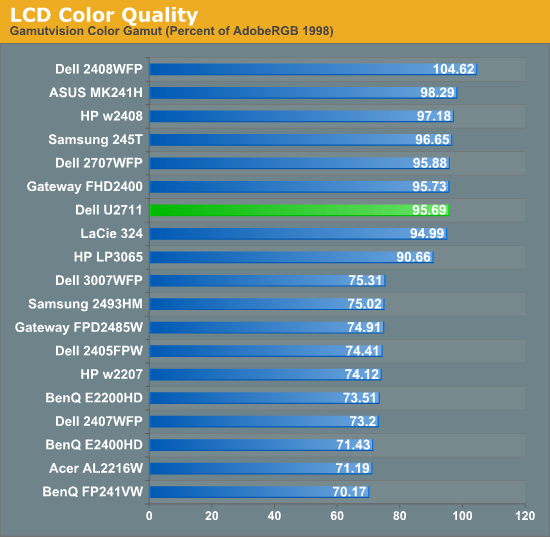
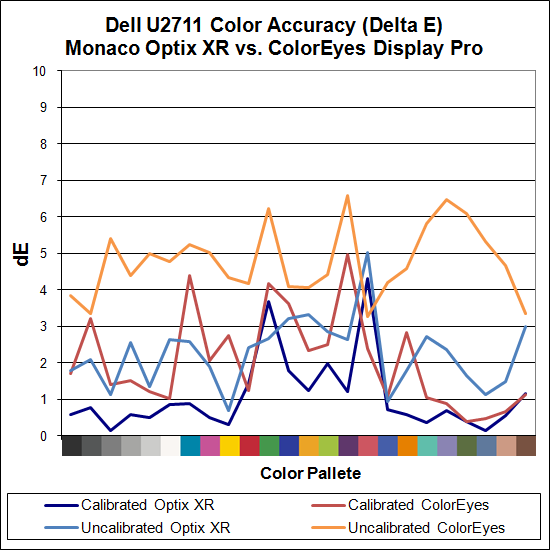
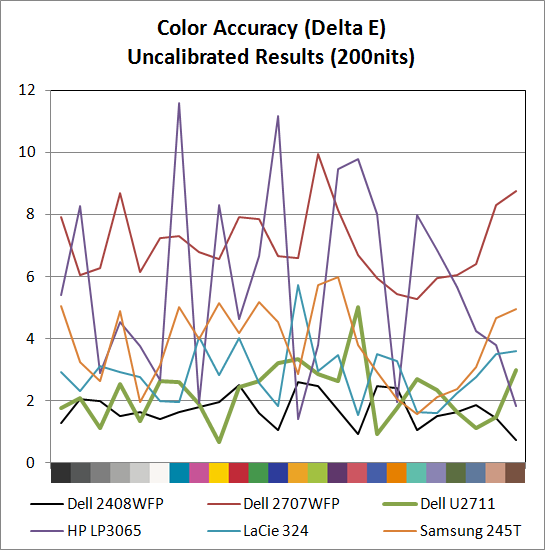
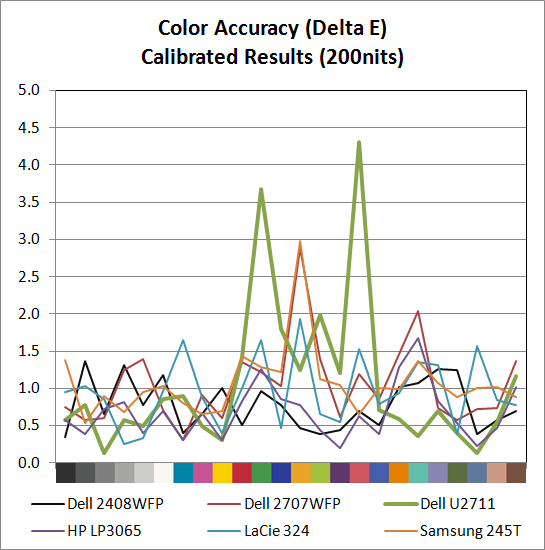
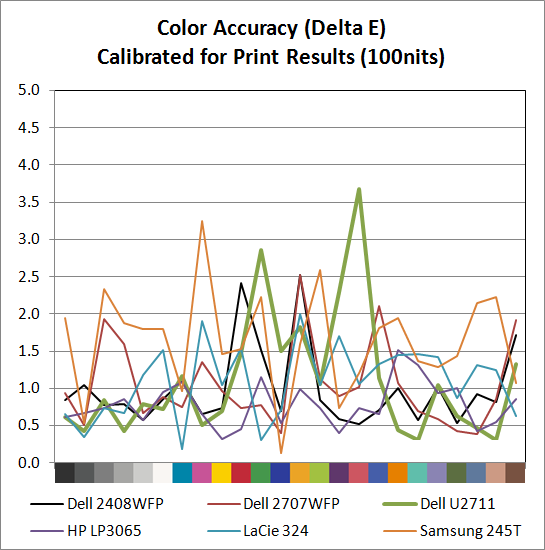
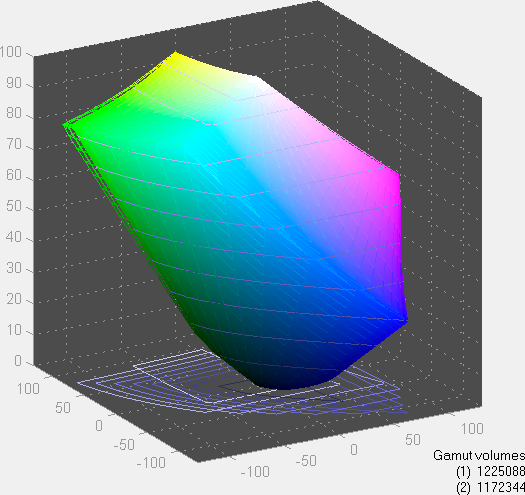
The U2711 scores extremely well in color gamut, and it achieves the 96% of Adobe RGB that Dell claims in their literature (not that most users would really notice the difference between any of the displays rated 90% to 105% - at least not after you eliminate the TN panels). Color accuracy on the other hand is a bit of a mixed bag. Dell ships a paper with test results showing the color calibration of each individual U2711, with the claim that the displays will have an average Delta E of less than 5.0 without any end-user calibration (when using the sRGB and Adobe RGB settings). Dell uses Minolta Color Analyzer CA210 and 32 test colors while we test with ColorEyes Display Pro and Monaco Optix XR Pro and 24 test colors, but our Monaco results confirm their claim. We're not sure why, but we continue to get better results using Optix XR Pro than with ColorEyes Display Pro.
As far as Optix is concerned, the U2711 achieves the rated Delta E of < 5.0 at just 2.24 without calibration, which is an excellent result. In fact the U2711 has no colors in the standard Gretag Macbeth 24 color palette score higher than 5.0 (and only reddish-pink scores a 5.0 measurement). The only LCD we've tested that did better is Dell's own 2408WFP (which also, interestingly enough, had an Adobe RGB color gamut of 105%). ColorEyes also gives an average Delta E of less than 5.0, but at 4.78 the score isn't nearly as remarkable, with nine color measurements well above 5.0. The uncalibrated (Monaco) results put the U2711 ahead of the HP LP3065, Dell 2707WFP, Samsung 245T, and LaCie 324 - and just about every other LCD we've tested.
Switch to the calibrated results and the U2711 doesn't impress quite as much relative to the competition. Monaco gives the U2711 an average Delta E of 1.06, which is great, but there are two results above 3.0 (the worst is reddish-pink again, this time at 4.31) compared to displays like the HP LP3065 where the highest measured Delta E is just 1.68. Dell's own 2707WFP, a three-year-old offering, also delivered a similar average Delta E but with only two colors above 2.0 (and still under 3.0). For a better LCD (i.e. not a TN panel), the results are really only slightly above average. It is possible different calibration software would achieve a better end result, but really we're talking about a "problem" that only the most demanding users are likely to ever notice.
Color Consistency
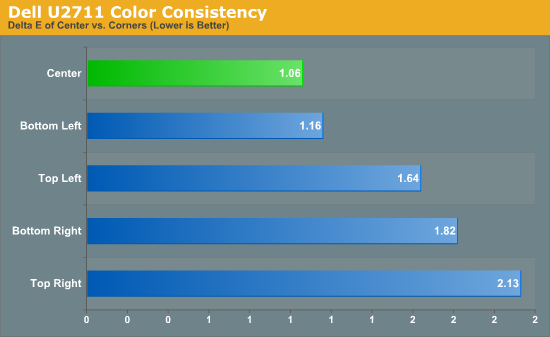
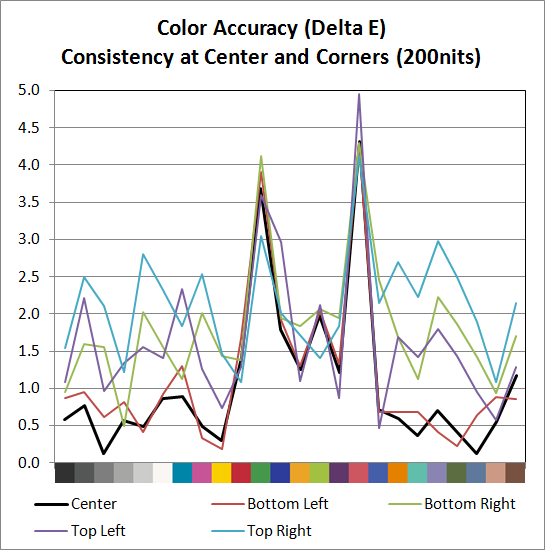
We added another test to try and measure the panel consistency across the entire surface. We measure Delta E at the center of the display, but what happens on the edges? To test this, we used the same profile generated in our best Delta E test result and measured Delta E again at the four corners. Most of the scores are similar, with a slight increase in average Delta E relative to the center measurement. The bottom-left corner is nearly identical to the center measurement, the top-left and bottom-right are a bit worse, and the top-right corner gets the overall worst result. While on the one hand we could say that the Delta E on the top-right is twice that of the center measurement, it's not a case of being "twice as bad". In fact, the color consistency is very good, and we didn't notice any "hot spots" are areas where the colors were clearly off relative to the rest of the LCD.










153 Comments
View All Comments
Zebo - Friday, January 22, 2010 - link
I only buy NEC after dozens of tries and finally found nirvana on 20wmgx2 and 2490wuxi. I hope NEC comes out with high res 27 like this then I'm in.IMO- Most LCD's tend to look grainy - as in I can see pixels, especially so in the 26/27's current out there. This panel will alleviate much of that.
GTVic - Friday, January 22, 2010 - link
Thanks for the article, there are many people who don't mind spending more for a quality display. 24" 1920x1200 would be my next choice, this is a bit too large/costly if you want multiple displays.My guess is that the 11 in U2711 is distinguishing it from the U2410 which had some issues that are mostly fixed now. Doesn't sound like they will come out with a U2411 or will they?
Affectionate-Bed-980 - Friday, January 22, 2010 - link
If you're gonna compare this monitor, it HAS to be compared against the Dell 2707. I see the 2707 in many of the tests, but not all. WHY? The best candidates to test against are the U2410, 2408, 2707, and even 3008. Why the heck would you be so inconsistent and use only some monitors in some test and different batches in others? Sigh @ anandtech inconsistency. I know you want to use old data and stuff that's available, but when you make these reviews, please consider reviewing against things that matter.... and KEEPING those test candidates in 100% of the time.strikeback03 - Friday, January 22, 2010 - link
Probably depends what tests they were doing when they had that monitor. If it was a test unit sent by Dell they had to send it back, so unless someone bought one of those it is no longer available for all tests.JarredWalton - Friday, January 22, 2010 - link
As far as the monitors you mentioned, the 2707WFP and 2408WFP are in all of the graphs, with the exception of power -- I didn't test that on the 2707WFP way back when. Same goes for input lag testing -- I started that long after my tests of the 2707WFP and 3007WFP. As for the U2410 and the 3008WFP (along with the 3007WFP-HC), I never have tested any of those and thus can't include data for them.The HP LP3065 will perform very similarly to the 3007WFP-HC and 3008WFP (but the 3008 will have more processing lag). For the charts where I limited the results to a few monitors, I specifically chose the monitors in order to show good, high-end offerings that would compete with the U2711. Obviously, I'm limited to what I've tested, so I used the 2408WFP, 2707WFP, HP LP3065, Samsung 245T, and LaCie 324.
Hope that helps... I'd love to provide results for the 2707WFP, but I can't. I could run tests on my 3007WFP (non-HC), but it's failing on me because it's three years old. Not *failing* really, but I've got some definite image persistence problems now (e.g. if I have content open where there's a start green/white vertical area, and then move that image a bit after 10 minutes, I can see an afterimage for at least 30-45 seconds.)
thedeffox - Friday, January 22, 2010 - link
Nice article.I'd be interested in hearing more about deep color selling point of this display. Perhaps it'd be worthy to explore in a future article. Specifically the complete line of components to enable it, and whether there is any noticeable difference.
It sounds like all the parts are out now for the non-pro to use deep color. Windows 7, the GT240 (are there any better gaming cards with DC support?), and a couple LCDs.
araczynski - Friday, January 22, 2010 - link
as a gamer, i'll take my 28" hanns-g for $240 over the "latest and greatest milking scheme" from anyone else.although i can see professional (not pretend professional) photographers being quite excited at this one perhaps.
as a programmer (at work) i'm happy with my 4 other LCD monitors, 24 dell, 20 dell, 19 acer, 18 nec (they still around?).
i think we're at the point of 'them' just trying to milk the lcd technology for every last dollar they can before moving on to the next 'in' thing.
Griswold - Sunday, January 24, 2010 - link
Considering that hanns-g is below average even for the (low) standards of gaming, it doesnt really matter what your opinion on this higher quality product is. Stick to what you know...kmmatney - Saturday, January 23, 2010 - link
As a gamer, I can tell you that the 28" Hanns-G is terrible for gaming. At least if you've ever used something better. I had one for about 2 years, used mostly for work, but I did try to use it for gaming. It is horrible with dark scenes, the top of the screen is darker than the rest (viewing angle limitation) and the contrast was poor. About the only acceptable scenario were bright outdoor games like Farcry. After using my Soyo MVA panel, I could never go back to using the HannsG anymore for gaming. The HannsG was fine for work (I'm a programmer/engineer), but not games.yacoub - Friday, January 22, 2010 - link
"The final potential drawback with the U2711 that we want to discuss is lag. There are actually two types of lag we noticed during testing, and neither one is likely to be a deal breaker if what you're after is high quality image. Processing lag (a.k.a. "input lag") is definitely present, and it appears to be due in part to the digital scaler."Blah. IPS is all about NOT having the input lag PVA panels have. Making an IPS panel that has noticeable input lag means it no longer has one of its biggest benefits.